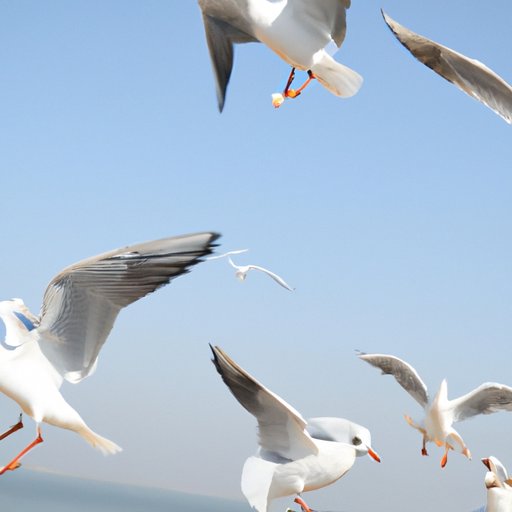Introduction
Seagulls are a common sight along the coasts and bodies of water around the world. These birds are well-known for their scavenging habits, but what about their fish consumption? Do seagulls eat fish, and if so, what types of fish do they consume? Understanding the feeding habits of these coastal birds can help us appreciate their role in the marine ecosystem and better coexist with them in our environment.
Types of Fish Eaten by Seagulls: A Comprehensive Guide
Seagulls are opportunistic feeders and will eat a wide variety of fish. Some of the most common types of fish consumed by seagulls include herring, mackerel, anchovy, and sardines. These fish are often found in abundance near the coast or in areas where there is a lot of fishing activity. Seagulls are also known to eat larger fish, such as cod and salmon, and they may scavenge for fish scraps or discarded fishing bait.
One way to identify the types of fish that seagulls are eating is to observe their behavior. For example, if a seagull is diving into the water to catch fish, it is likely pursuing small, fast-moving prey like anchovy or herring. If a seagull is flying overhead with a larger fish in its beak, it may have caught a flounder or other bottom-dwelling fish.
Do Seagulls Eat Only Fish? The Other Foods They Consume
While fish may be a primary food source for seagulls, they do consume other foods as well. Insects, crustaceans, and even garbage are all potential food sources for seagulls. In fact, urban seagulls have been known to scavenge in trash cans and landfills for food.
Seagull food habits can vary depending on factors such as location and season. For example, seagulls may consume more insects in the summer months when these creatures are in greater abundance. Similarly, seagulls that live in urban environments may rely more heavily on garbage as a food source than those that live near the coast.
The Role of Seagulls in the Marine Ecosystem: A Focus on Their Fish Consumption
Seagulls play an important role in the marine ecosystem. As predators, they help to keep populations of smaller fish and other marine creatures in check. When seagulls feed on smaller fish, they may be preventing these species from becoming overpopulated and consuming too much of the ecosystem’s resources.
However, seagulls can also have negative impacts on the marine ecosystem when they consume too much of one particular food source. For example, if seagulls consume too many herring or anchovy, it could disrupt the balance of the marine food chain and have ripple effects throughout the ecosystem.
The Fascinating Science Behind Seagulls’ Ability to Catch Fish
Seagulls are incredibly skilled hunters when it comes to catching fish. One of their key adaptations is their sharp, curved beak, which they use to grab and hold onto slippery prey. Seagulls also have excellent eyesight, which allows them to spot fish swimming near the surface of the water from hundreds of feet in the air.
Another interesting feature of seagulls is their ability to drink salt water. Seagulls have a specially adapted pair of glands above their eyes that filter out salt from seawater, allowing them to drink without becoming dehydrated.
Understanding Seagulls’ Feeding Behavior: How, When, and Why They Eat Fish
Seagulls have specific feeding habits when it comes to consuming fish. They are most active in the early morning and late afternoon, when fish are closer to the surface of the water. Seagulls may also follow boats or other marine vessels to scavenge for fish scraps or bait.
Beyond obtaining sustenance, seagulls hunt and eat fish for a variety of reasons. For some, it may be an instinctual behavior that has been passed down through generations. Others may hunt and eat fish for the social aspects of the activity, as seagulls are known to gather in groups to hunt and eat together.
Seagulls and Fishermen: A Historic Tension Over Fish Consumption
Seagulls and fishermen have a long history of conflict over fish consumption. Fishermen see seagulls as competition for their catch and may resort to drastic measures to keep the birds away. Conversely, seagulls have been known to damage fishing nets and equipment in their attempts to scavenge for fish.
One potential solution to this problem is for fishermen to implement bird-friendly fishing practices. For example, they could avoid dumping fish scraps overboard when seagulls are present and instead dispose of the scraps onshore. This could help to reduce the number of seagulls that are attracted to boats and equipment.
Conclusion
Seagulls are fascinating creatures that play an important role in the marine ecosystem, but their feeding habits can sometimes cause problems for humans. By understanding more about how seagulls hunt and eat fish, we can better appreciate these coastal birds and take any necessary steps to prevent conflicts with them in our environment.
Remember, while seagulls may seem like a nuisance when they’re diving for fish or scavenging in garbage cans, they are an important part of the ecosystem. Let’s do our part to coexist peacefully with these feathered neighbors.
(Note: Is this article not meeting your expectations? Do you have knowledge or insights to share? Unlock new opportunities and expand your reach by joining our authors team. Click Registration to join us and share your expertise with our readers.)
